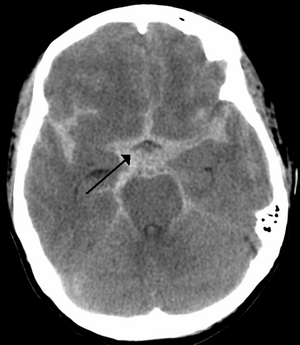Subarachnoid bleed
| Subarachnoid hemorrhage | |
|---|---|
| Synonyms | Subarachnoid haemorrhage |
 |
|
| CT scan of the brain showing subarachnoid hemorrhage as a white area in the center and stretching into the sulci to either side (marked by the arrow) | |
| Pronunciation | |
| Specialty | Neurosurgery |
| Symptoms | Severe headache of rapid onset, vomiting, decreased level of consciousness |
| Complications | Delayed cerebral ischemia, cerebral vasospasm, seizures |
| Types | Traumatic, spontaneous (aneurysmal, nonaneurysmal, perimesencephalic) |
| Causes | Head injury, cerebral aneurysm |
| Risk factors | High blood pressure, smoking, alcoholism, cocaine |
| Diagnostic method | CT scan, lumbar puncture |
| Similar conditions | Meningitis, migraine, cerebral venous sinus thrombosis |
| Treatment | Neurosurgery or radiologically guided interventions |
| Medication | Labetalol, nimodipine |
| Prognosis | 45% risk of death at 30 days (aneurysmal) |
| Frequency | 1 per 10,000 per year |
| Classification |
· ·
|
|---|---|
| External resources |
Subarachnoid hemorrhage (SAH) is bleeding into the subarachnoid space — the area between the arachnoid membrane and the pia mater surrounding the brain. Symptoms may include a severe headache of rapid onset, vomiting, decreased level of consciousness, fever, and sometimes seizures. Neck stiffness or neck pain are also relatively common. In about a quarter of people a small bleed with resolving symptoms occurs within a month of a larger bleed.
SAH may occur as a result of a head injury or spontaneously, usually from a ruptured cerebral aneurysm. Risk factors for spontaneous cases included high blood pressure, smoking, family history, alcoholism, and cocaine use. Generally, the diagnosis can be determined by a CT scan of the head if done within six hours. Occasionally a lumbar puncture is also required. After confirmation further tests are usually performed to determine the underlying cause.
Treatment is by prompt neurosurgery or radiologically guided interventions. Medications such as labetalol may be required to lower the blood pressure until repair can occur. Efforts to treat fevers are also recommended.Nimodipine, a calcium channel blocker, is frequently used to prevent vasospasm. Routine use medications to prevent further seizures is of unclear benefit. Nearly half of people with a SAH due to an underlying aneurysm die within 30 days and about a third who survive have ongoing problems. 10–15 percent die before reaching a hospital.
...
Wikipedia
